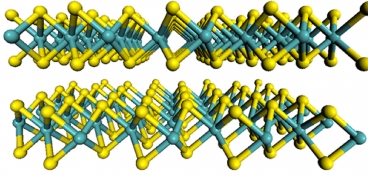Graphene is hailed for its superior properties and has been the focus of numerous research studies attempting to extend its application in various spheres such as structural materials, optics and electronics.
 Flat sheet structure of MoS2. Yellow atoms represent Sulphur while Teal atoms represent molybdenum. (Credit: Wang et al. MIT)
Flat sheet structure of MoS2. Yellow atoms represent Sulphur while Teal atoms represent molybdenum. (Credit: Wang et al. MIT)
Recent research however indicates that the single-layered graphene may be just the tip of a whole new class of possible two-dimensional (2D) materials with equal potential for applications. One such material is molybdenum disulfide (MoS2), which has been used as an industrial lubricant for decades. The material was first described in its two-dimensional form in 2011 when researchers at the Switzerland University EPFL designed a transistor from the material. MIT researchers, who have been attempting to devise electronic circuits from graphene for many years now, latched on the concept of two-dimensional MoS2.
The MIT researchers employed chemical vapor deposition to make large sheets of MoS2. The team found it much easier to develop the various components of an electronic circuit using the new material. The main drawback of using graphene is that it does not possess a band-gap. This impedes its use in transistors which are integral to logic circuits and memory devices. As opposed to the exacting methods required to create band-gaps on graphene, MoS2 naturally possesses a band-gap. MoS2 is the solution for researchers who have been looking for a graphene alternative that possesses the desirable characteristics of graphene without its limitations.
Some of the electronic devices the MIT team fabricated out of MoS2 are a NAND gate, an inverter, a ring oscillator and a memory device. The new material could be combined with other 2D materials to give rise to innovative products such as clothing with embedded electronics, glowing walls and glasses with built-in display screens.